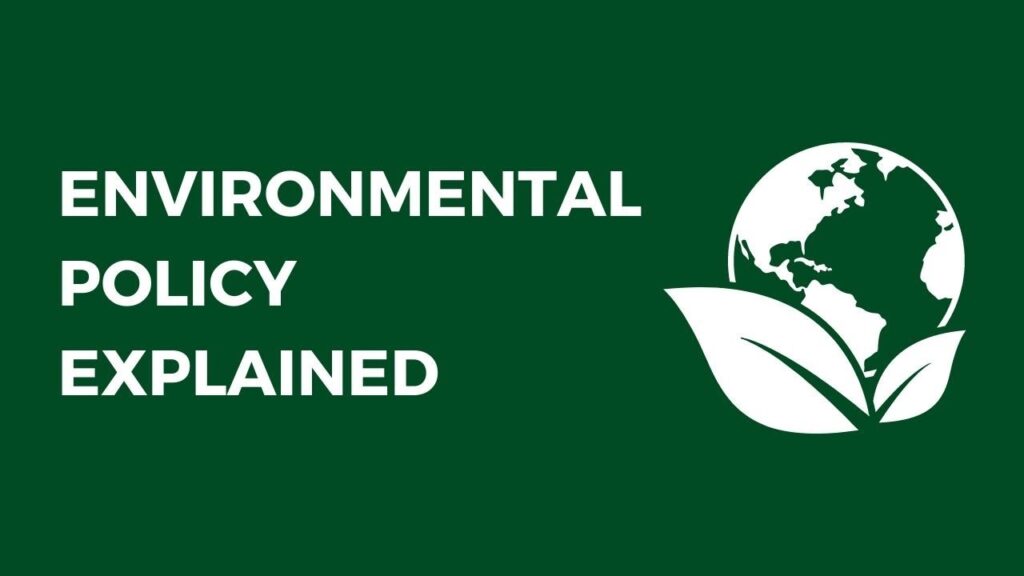In a rapidly changing world where environmental concerns, economic stability, and social well-being intersect, the concept of sustainability has emerged as a critical guiding principle.
Sustainability, in its essence, embodies the delicate balance between meeting the needs of the present generation without compromising the ability of future generations to meet their own needs.
As global challenges like climate change, resource depletion, and social inequality intensify, the role of government policies in promoting sustainability has never been more pivotal.
This article delves deep into the multifaceted realm of sustainability and its intricate relationship with government policies.
We will embark on a comprehensive journey through time, exploring the historical evolution of sustainability as a global concern and the early governmental endeavors that laid the foundation for today’s sustainable policies.
Join me as I navigate the intricate web of environmental, economic, and social sustainability policies, dissecting the mechanisms by which governments worldwide aim to mitigate environmental degradation, foster economic growth, and enhance the well-being of their citizens.
Through case studies, expert insights, and an exploration of the Sustainable Development Goals (SDGs), we will unveil the impact, successes, and challenges inherent in government-led sustainability efforts.
But it doesn’t stop there.
We will also shine a light on the criticisms and obstacles that policymakers face in their pursuit of sustainability, offering a balanced view of this complex landscape.
Furthermore, we will peer into the future, unveiling emerging trends, innovative technologies, and global collaborations that promise to reshape the way governments approach sustainability in the years to come.
So, fasten your seatbelts as we embark on a journey to uncover the pivotal role that government policies play in steering our world towards a more sustainable and equitable future.

Historical Context
A. Evolution of sustainability as a global concern
The concept of sustainability, which encompasses environmental, economic, and social dimensions, has not always been at the forefront of global discourse.
To truly appreciate the role of government policies in promoting sustainability, it’s essential to understand how this concern evolved over time.
I’ll go into the historical roots of sustainability, tracing its journey from a niche idea to a central pillar of global governance.
B. Early governmental efforts in sustainability
While sustainability may seem like a contemporary buzzword, governments around the world have been addressing various aspects of sustainability for centuries.
In this subsection, I’ll examine early governmental initiatives aimed at conserving natural resources, promoting responsible land use, and addressing societal well-being.
These early endeavors laid the foundation for the comprehensive policies we see today.
C. Milestones in sustainable policy development
The road to sustainable governance is marked by significant milestones.
I’ll explore pivotal moments in history where governments took decisive steps towards sustainability, such as the establishment of national parks, the adoption of pollution control measures, and the creation of international agreements.
By examining these milestones, we can gain valuable insights into the evolution of sustainable policy-making on a global scale.
Environmental Sustainability Policies
A. Overview of environmental sustainability
Environmental sustainability lies at the core of efforts to safeguard our planet for future generations.
In this section, I’ll provide a comprehensive overview of what environmental sustainability entails.
I’ll discuss the interconnectedness of ecosystems, the importance of biodiversity, and the need to address issues like climate change, pollution, and resource depletion.
B. Governmental regulations on air quality
Clean air is a fundamental requirement for a healthy environment and human well-being.
Governments worldwide have implemented various policies to improve air quality, reduce emissions, and combat air pollution.
I’ll delve into these regulations, exploring how governments set and enforce standards to protect their citizens’ respiratory health and mitigate the effects of air pollution on the environment.
C. Water resource management policies
Access to clean and abundant water is vital for life, making the responsible management of water resources a top priority.
In this subsection, I’ll examine how governments formulate policies to ensure the sustainable use and conservation of freshwater sources.
This includes discussions on water quality standards, water allocation, and strategies for mitigating water scarcity.
D. Forest and biodiversity conservation initiatives
Forests and biodiversity are invaluable components of our planet’s ecosystems.
Governments play a critical role in preserving these natural treasures through conservation initiatives and policies.
I’ll explore the strategies governments employ to protect forests, wildlife, and fragile ecosystems.
Additionally, I’ll discuss the significance of international agreements and conventions in promoting global biodiversity conservation efforts
Economic Sustainability Policies
A. Introduction to economic sustainability
Economic sustainability is a key facet of ensuring the long-term well-being of societies.
In this section, I’ll introduce the concept of economic sustainability and its importance within the broader sustainability framework. I’ll discuss the principles of responsible resource management, equitable economic growth, and the pursuit of prosperity without compromising future generations’ economic prospects.
B. Government incentives for green industries
Governments worldwide are recognizing the economic potential of green industries, which focus on environmentally friendly products and services.
I’ll delve into how governments use incentives, subsidies, and support programs to foster the growth of green businesses and promote sustainable practices.
This includes discussions on renewable energy, eco-friendly technology, and sustainable agriculture.
C. Tax policies promoting sustainable practices
Taxation policies can serve as powerful tools for encouraging sustainability.
I’ll explore how governments use tax incentives and penalties to drive sustainable behaviors among individuals and businesses.
Topics will include tax credits for energy-efficient investments, carbon taxes, and other fiscal measures designed to align economic activities with sustainability goals.
D. Support for sustainable agriculture
Agriculture is both a major economic sector and a critical factor in environmental sustainability.
I’ll examine how governments develop policies to support sustainable agriculture practices, including organic farming, crop rotation, and soil conservation.
Additionally, I’ll discuss initiatives to promote local food systems, reduce food waste, and ensure food security in a changing world.
Social Sustainability Policies
A. Understanding social sustainability
Social sustainability is a vital component of creating a balanced and equitable society.
In this section, we’ll explore the concept of social sustainability, focusing on the well-being and quality of life of individuals and communities.
I’ll discuss the importance of social cohesion, inclusivity, and addressing societal challenges such as poverty, inequality, and access to basic services.
B. Affordable housing and urban planning
Access to safe and affordable housing is a fundamental human right and a key aspect of social sustainability.
Governments play a crucial role in shaping housing policies, urban planning, and land use regulations to ensure that communities have access to suitable living conditions.
I’ll delve into how governments address housing affordability, homelessness, and sustainable urban development.
C. Social welfare programs and sustainability
Social welfare programs are instrumental in providing a safety net for vulnerable populations.
I’ll examine how governments design and implement social welfare policies to address issues such as healthcare, education, unemployment benefits, and poverty alleviation.
I’ll also explore the connection between social welfare and long-term sustainability.
D. Education and awareness campaigns
Education and awareness are potent tools for fostering a sustainable society.
Governments often initiate campaigns to educate citizens about sustainability issues, climate change, and responsible consumption.
In this subsection, I’ll discuss the role of government-sponsored educational programs and initiatives in promoting environmentally conscious behaviors and fostering a sense of social responsibility.
The Intersection of Sustainable Development Goals (SDGs)
A. Alignment of government policies with SDGs
The Sustainable Development Goals (SDGs) established by the United Nations provide a comprehensive framework for addressing global challenges.
Governments worldwide have recognized the importance of aligning their policies with these goals.
In this section, I’ll explore how governments integrate and prioritize the SDGs within their sustainability agendas, emphasizing the interconnectedness of these global objectives.
B. Case studies on countries successfully implementing SDGs through policies
To illustrate the practical application of SDGs in policy-making, I’ll delve into case studies of countries that have made significant progress.
These examples will highlight specific policies and initiatives that effectively advance multiple SDGs, demonstrating the positive outcomes that can be achieved through strategic governmental actions.
C. Challenges in achieving multiple SDGs simultaneously
While the SDGs offer a roadmap for sustainability, their simultaneous pursuit can be complex.
Governments often face challenges in balancing competing goals, resource allocation, and conflicting priorities.
In this subsection, I’ll explore the difficulties and trade-offs that governments encounter when striving to achieve multiple SDGs and how they navigate these challenges.
Evaluating the Impact of Government Policies
A. Metrics for assessing the success of sustainability policies
Effectively evaluating the impact of government policies on sustainability requires robust metrics and indicators.
In this section, I’ll explore the various quantitative and qualitative measures that experts and policymakers use to gauge the success of sustainability policies.
I’ll discuss key performance indicators, data collection methods, and assessment frameworks that help track progress.
B. Case studies showcasing positive outcomes
To illustrate the tangible results of sustainability policies, I’ll present case studies that highlight successful initiatives from different regions and domains.
These real-world examples will showcase how well-designed government policies can lead to positive environmental, economic, and social outcomes, underscoring the potential for transformative change.
C. Areas where government policies need improvement
No policy is without its challenges and limitations.
In this subsection, I’ll critically examine areas where government sustainability policies may fall short or face resistance.
By acknowledging these shortcomings, we can identify opportunities for refinement and improvement in policy design and implementation, ultimately working toward more effective and comprehensive sustainability solutions.
Challenges and Criticisms
A. Common criticisms of government sustainability policies
While government policies play a crucial role in promoting sustainability, they are not immune to criticism.
I’ll explore some common critiques that skeptics and experts alike raise regarding the effectiveness and impact of these policies.
This section will provide a balanced view of the challenges that policymakers face in their pursuit of sustainability.
B. Balancing economic growth with environmental protection
One of the central challenges governments encounter is finding the delicate equilibrium between economic growth and environmental protection.
In this subsection, I’ll delve into the complexities of this balance, discussing how policies aimed at bolstering economies can sometimes inadvertently harm the environment.
I’ll also explore strategies for achieving sustainable growth without compromising natural resources.
C. Political obstacles to sustainable policy implementation
The implementation of sustainable policies often encounters political hurdles, including partisan divides, lobbying interests, and short-term electoral cycles.
I’ll examine how these political factors can impede the progress of sustainability initiatives and explore potential strategies for overcoming these obstacles.
This section will shed light on the need for bipartisan collaboration and long-term thinking in sustainability policymaking.
Future Trends and Innovations
A. Emerging technologies in sustainable policy-making
The landscape of sustainable policy-making is continually evolving with the integration of cutting-edge technologies.
In this section, I’ll explore the role of emerging technologies such as artificial intelligence, blockchain, and data analytics in enhancing the development, implementation, and monitoring of sustainability policies.
These innovations have the potential to revolutionize how governments address sustainability challenges.
B. Global cooperation for addressing sustainability challenges
In an increasingly interconnected world, addressing sustainability challenges requires international collaboration.
I’ll discuss the importance of global partnerships, multilateral agreements, and diplomacy in tackling cross-border sustainability issues.
I’ll also highlight initiatives and forums where governments come together to share knowledge, resources, and best practices for a more sustainable future.
C. The role of grassroots movements in shaping government policies
Sustainability is not solely a top-down endeavor.
Grassroots movements, driven by concerned citizens, have played a significant role in raising awareness and advocating for change.
In this subsection, I’ll examine how grassroots activism influences government policies and serves as a catalyst for sustainability initiatives.
I’ll also explore the power of public engagement and social movements in shaping the policy agenda.
Global Perspective
A. Comparative analysis of sustainability policies across different countries
Sustainability is a global concern, and governments around the world approach it differently.
In this section, I’ll conduct a comparative analysis of sustainability policies across diverse countries and regions.
By examining variations in policy design, implementation, and outcomes, we can gain valuable insights into the effectiveness of different approaches and identify best practices.
B. International treaties and agreements promoting global sustainability
The global nature of sustainability challenges requires international cooperation.
I’ll explore the role of international treaties, agreements, and conventions in advancing sustainability goals.
This includes discussions on landmark agreements like the Paris Agreement on climate change and the Convention on Biological Diversity, highlighting their significance in shaping global sustainability efforts.
C. The influence of geopolitics on sustainability efforts
Geopolitical factors can significantly impact the success of sustainability policies.
I’ll examine how geopolitical tensions, alliances, and power dynamics affect the ability of governments to implement sustainable practices.
By understanding the geopolitical context, we can better appreciate the complexities of global sustainability governance and the need for diplomatic solutions to shared challenges.
Case Studies
A. Examining specific countries or regions as models of sustainability
To gain practical insights into the impact of government policies, we’ll delve into case studies of countries or regions that have excelled in promoting sustainability.
These real-world examples will showcase the policies, strategies, and initiatives that have positioned them as global leaders in sustainability, offering valuable lessons for other nations.
B. Highlighting innovative policies that have achieved remarkable results
In this subsection, I’ll zoom in on specific sustainability policies or programs that have yielded remarkable results.
These could range from renewable energy incentives and waste reduction initiatives to community-based conservation projects.
By spotlighting innovative policies, we can demonstrate the potential for creative solutions to sustainability challenges.
C. Lessons learned from successful cases
Success stories often come with valuable lessons.
I’ll analyze the key takeaways from the case studies presented earlier in the article.
By distilling the principles and strategies that underpin successful sustainability policies, we can offer actionable insights for policymakers and advocates seeking to replicate these achievements in their own contexts.
FAQs
A. What is the main objective of government sustainability policies?
Government sustainability policies aim to strike a balance between environmental protection, economic prosperity, and social equity. Their primary objective is to promote practices and initiatives that ensure the well-being of current and future generations by addressing environmental challenges, fostering economic growth, and enhancing societal welfare.
B. How do government policies impact businesses’ sustainability efforts?
Government policies can significantly influence businesses’ sustainability efforts. These policies may offer incentives, tax benefits, or regulatory requirements that encourage businesses to adopt eco-friendly practices, reduce emissions, and invest in sustainable technologies. In some cases, governments may also provide funding for research and development in sustainable industries.
C. Are there any notable examples of countries leading in sustainable policy-making?
Yes, several countries are recognized for their exemplary sustainable policy-making. Countries like Sweden, Denmark, Norway, and Finland consistently rank high in global sustainability indices. They have implemented a range of policies promoting renewable energy, sustainable transportation, and environmental conservation.
D. What challenges do governments face in implementing sustainability policies?
Governments encounter various challenges when implementing sustainability policies. These challenges may include political opposition, budget constraints, conflicting interests, and the need to balance short-term economic goals with long-term sustainability objectives. Additionally, the complexity of global issues like climate change poses unique implementation challenges.
E. How can individuals and communities contribute to the success of these policies?
Individuals and communities play a crucial role in supporting sustainability policies. They can contribute by adopting eco-friendly practices in their daily lives, participating in local environmental initiatives, and advocating for sustainable policies at the grassroots level. Engaging in education and awareness campaigns and making sustainable choices in consumption are also impactful ways to contribute.
F. What are the potential consequences of not addressing sustainability through policies?
Failing to address sustainability through policies can lead to a range of consequences. These may include worsening environmental degradation, resource depletion, economic instability due to climate-related events, and social inequities. In the long term, neglecting sustainability can threaten the well-being and future prospects of both current and future generations.
Conclusion
In a world at the crossroads of environmental challenges, economic aspirations, and social well-being, government policies emerge as the guiding force steering us toward a sustainable future.
Our journey through the intricate landscape of sustainability and the policies that shape it has been illuminating, revealing the multifaceted role that governments play in safeguarding our planet and society.
From the historical evolution of sustainability as a global concern to the early governmental efforts that laid its foundation, we have witnessed the remarkable progress humanity has made.
Governments have embraced environmental sustainability by regulating air quality, managing water resources, and conserving our precious forests and biodiversity.
Economic sustainability has also been at the forefront, with governments fostering green industries, designing tax policies to incentivize sustainable practices, and supporting agriculture that nurtures our planet rather than depleting it.
Social sustainability, equally essential, sees governments investing in affordable housing, social welfare programs, and education.
These endeavors aim to ensure that no one is left behind as we journey towards a more equitable world.
The Sustainable Development Goals (SDGs) serve as a compass, aligning governmental efforts on a global scale.
Case studies and real-world examples have illuminated the transformative power of government policies when effectively executed, showcasing that progress is indeed possible.
Yet, challenges and criticisms persist, from skeptics questioning the effectiveness of policies to the delicate task of balancing economic growth with environmental protection.
Political obstacles can also hinder progress, making it clear that sustainability is a complex puzzle with no easy solutions.
Looking ahead, I’ve glimpsed future trends and innovations that promise to reshape sustainable policy-making.
Emerging technologies, global cooperation, and grassroots movements are the winds of change, driving us towards a more sustainable and equitable world.
Our global perspective has shown us that sustainability knows no borders.
From comparative analyses of policies across countries to the influence of geopolitics on sustainability efforts, it’s evident that international collaboration is the path forward.
The case studies have offered hope and inspiration, demonstrating that progress is possible, and success is attainable through strategic policies and collective efforts.
In conclusion, the role of government policies in promoting sustainability is undeniable.
As individuals, communities, and nations, we must recognize that our collective future depends on our ability to address sustainability challenges head-on.
It’s a call to action for all of us to support, advocate for, and participate in the transformative policies that will shape a sustainable and prosperous future for generations to come.
The journey towards sustainability continues, and together, we can navigate it towards a brighter tomorrow.
Also see:
The Challenges of Plastic Pollution And Possible Solutions
The Benefits of Renewable Energy Sources
The Impact of Deforestation on Biodiversity
How to Write Application Letter for Teaching Job as an Undergrad

Hello, I’m Emeka by name, an article writer with a passion for words and storytelling. I have a knack for crafting engaging and informative content that captivates readers and delivers valuable insights. Whether it’s exploring the latest trends, sharing knowledge, or diving into creative narratives, I’m here to bring words to life. Join me on a journey through the world of ideas and stories as we explore the power of written expression.





